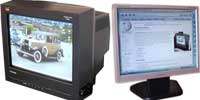Difference Between Dynamic Contrast and True Contrast

One of the major considerations when purchasing newer types of displays is the contrast ratio. It is the measurement of the degree of separation between the brightest and darkest values that the display is able to reproduce. Most LCD displays have trouble recreating black as some of the light from the backlight is still able to seep through the LCD. The biggest difference between the two is the usual values. For the same display, the dynamic contrast is much higher compared to the true contrast.
The true contrast is also commonly referred to as static contrast. The measurement is done while the brightness of the backlight is kept a constant value. The high dynamic contrast ratios are achieved by the intelligent control of the backlight brightness. In dark scenes, the display would dim the backlight, allowing for much darker blacks. This technique can be problematic when majority of the image is dark with a small bright area as it can cause oversaturation of the image.
Displays that use LED backlights are much better at staying true to the dynamic contrast that is stated. CFL bulbs are quite prone to the problem stated above. LED displays use a number of smaller bulbs that can be turned on or off independently of each other. This ability allows the display show really dark areas while still showing bright spots. It is up to the circuitry to maintain intelligent control over the backlight.
In choosing between displays to bring home, it is still best to know which one has the higher true contrast as it truly describes the superiority of the LCD. The dynamic contrast ratio should take lesser priority as its effectiveness can be hit or miss, depending on the video that is being played. It also pays to know whether the display is equipped with CFL or LED backlighting as it can give a little bit more weight to the dynamic contrast ratios that are being advertised by the manufacturer.
After all that, nothing still beats a side by side comparison of two displays while showing the identical videos. Knowing the true and dynamic contrast ratios should help you narrow down your choices before you do an actual side by side comparison.
Summary:
1. Dynamic contrast values tend to be much higher than the true contrast value
2. Dynamic contrast values are achieved by varying the brightness of the backlight while true contrast is done at a fixed brightness
3. True contrast is a more reliable basis for the capability of a display compared to dynamic contrast
- Difference Between Sony Cybershot S Series and W Series - December 22, 2012
- Difference Between Samsung Galaxy S3 and iPhone 5 - December 21, 2012
- Difference Between Samsung Galaxy S2 (Galaxy S II) and Galaxy S 4G - December 20, 2012
